On January 30, 1972 the British Army opened fire on civil rights marchers in Derry. Thirteen people were killed and 14 others were seriously injured.
Note: This story was filed in March, 2000 when a new inquiry into the Bloody Sunday killings, the Saville Inquiry was launched. Expected to last two years, it was 12 years before a report was filed.
The wounded survivors and the families of the dead sit stone-faced in Derry’s Guildhall listening to details of a story they already know: that on Sunday, January 30, 1972 British soldiers opened fire on a civil rights march in the city, that 27 unarmed civilians were hit, that thirteen died that day and one later died from wounds.
A new Inquiry (the Saville Inquiry) into the Bloody Sunday killings started in late March [2000] that is expected to last for two years.
Two days after Bloody Sunday happened, British government representatives issued a statement in New York claiming that the soldiers had fired in self-defense, that four of those killed were on the security force’s wanted list, and that one man was found to have four nail bombs in his pocket.
Two months later, the British government’s inquest into the killings resulted in the Widgery Report, which exonerated the soldiers and blamed the march organizers for the violence. Despite overwhelming evidence to the contrary, it did not dismiss soldiers’ claims that those killed were carrying bombs or guns — “each soldier was his own judge of whether he had identified a gunman,” concluded Lord Widgery.
Forensic tests and eyewitness accounts have proved that none of those killed or wounded were carrying bombs or guns and few people now believe the Widgery Report was anything more than a political face-saver for then British Prime Minister Ted Heath. Pressure from the Bloody Sunday victims’ families and the Irish government has forced present Prime Minister Tony Blair into opening the new, wide-ranging Inquiry.
The Guildhall has been decked out with the latest hi-tech video monitors and computer technology. Dozens of lawyers sit behind shiny new desks that contrast with the old chamber’s dark-paneled walls and stained-glass windows.
Along one side sit the three judges appointed by Tony Blair: English Law Lord Mark Saville, the Inquiry’s Chair; Sir Edward Somers of New Zealand, and Canadian William Hoyt. To their right sit the families of the dead and wounded. Christopher Clarke, Counsel to the Inquiry, stands in front of the judges and leads them through the evidence. His opening statement is due to last four weeks.
This time the British government seems determined to show that there will be no rash to judgement, and has given the Inquiry considerable resources — £15 million has already been spent, and the final bill will be several times that.
Nearly 1,500 civilians, clergy, media, soldiers, police, politicians and government officials have already been interviewed as part of the Inquiry, and testimony is still coming in. The proceedings are relayed live via closed circuit TV to a local cinema for those who cannot squeeze into the chamber, and a transcript of each day’s proceedings is posted on the Inquiry’s website at www.bloody-sunday-Inquiry.org.uk.
That the Inquiry has happened at all is a victory for the families.
In 1992, at the twentieth anniversary there was a meeting to get people organized. The Bloody Sunday Justice Campaign was set up. “The families put it together with support from people like [civil rights leader] Eamonn McCann,” said John Kelly, who was elected Chair of the organization. “We put down three demands — the full declaration of innocence for those injured or killed, the repudiation of Widgery, and third, the prosecution of all those who planned or participated in the murder of our people.”
Momentum for the campaign grew slowly, but after meetings with senior figures in the Dublin government, and then American Ambassador to Ireland Jean Kennedy Smith, the families made some powerful allies. A trip to Washington, D.C. in 1997 and the publication of Don Mullan’s book Bloody Sunday Massacre in Northern Ireland, that same year, gave the campaign a further boost.
After the new Inquiry was announced in 1998, it spent two years scouring the globe for witnesses and collecting evidence. It is to have a far wider remit than the Widgery Inquiry, which limited itself to examining what happened during the afternoon of Bloody Sunday. But despite the Inquiry’s public accessibility and its declared commitment to “fairness, thoroughness and impartiality,” minor mistakes gnaw at its credibility.
Muffled groans come from the families’ seating area when a local name is mangled by a plummy English accent, or when a neighborhood is wrongly identified on a map. During a painstaking explanation of the layout of Derry’s streets a photograph was presented of the Rossville Flats, an area where several people were killed. In fact, the photograph was of a housing project in Belfast. Locals rolled their eyes and pointed out the mistake.
More significant is the decision to grant the soldiers anonymity, and possibly immunity. “We were promised an independent, open and impartial Inquiry,” said John Kelly. “But these [anonymity] rules destroy the openness of it, the independence has been undermined by the shenanigans of the Ministry of Defense and the impartiality has been undermined because of government departments interfering and Tony Blair saying he was pleased the soldiers had been granted anonymity.”
There is real concern about the British Ministry of Defense’s response to the Inquiry’s request to produce weapons believed to have been used on Bloody Sunday. The Ministry assured the Inquiry in September 1999 that although many of the rifles used by Paratroopers that day had been sold or destroyed, it still had five in its possession, but after it sent that letter it destroyed two more.
Despite these problems, the new Inquiry has already made public much evidence previously ignored or kept hidden. “For twenty-five years I believed that there was a young soldier out there who was scared and terrified when he came to Derry that day,” said Micky Bradley, who was wounded on Bloody Sunday. “Maybe he didn’t mean to shoot me, or shoot to kill me anyway. Maybe he was under orders. Two years ago I finally got the transcripts from the Widgery Tribunal. The [soldier] whom I thought had shot me was asked by Lord Widgery: `The person you aimed at, did you mean to kill him?’ and he said `Yes.’ It came home to me then that they were out to murder me.”
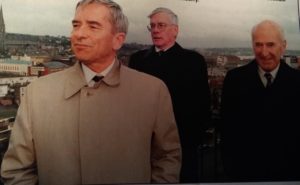
One of the areas the families hope the Inquiry will clear up is whether all those hit were shot by Paratroopers. There is some evidence that soldiers from other British regiments were firing down into the crowd from the city walls.
Another unresolved issue concerns shots fired at the British soldiers. In early April, the Inquiry heard from witnesses who claimed that although the IRA had agreed to stay away from the march and had ordered all of its weapons out of the Bogside area, a couple of guns remained, and several eyewitnesses claimed that a few rounds were loosed off, ineffectually, at British soldiers.
The Inquiry has also heard new evidence about the build-up to the march and the anticipation that something serious might happen. The Parachute Regiment, although known in Belfast for its ruthlessness, had never been deployed in Derry before that day, and many locals were nervous that the crack troops were to be used to control the march, which had been declared illegal.
“I knew there was going to be trouble on the march,” Donal Deeney told the Inquiry. “I was a rioter at the time and used to boast to my friends that I had not missed a single riot. I had my ear very close to the ground in terms of what was happening. We would get reports, usually from the Yankee base at the Waterside, where a number of local people worked. The Yankee base was an American NATO listening point. They were sympathetic Americans who would pass on information such as truck movements and intercepted officer/officer conversations on the airways. Reports came in that the Paras were going to `sort us out.'”
A milkman who delivered to British Army barracks and had befriended a black soldier there was warned by the soldier to stay away from the march. “He said the Paras were coming in to do serious damage and maybe even kill people.”
Many in Derry shared a sense of foreboding in the days leading up to the march, and the Inquiry has presented some evidence of a premeditated hardening of British policy at that time. Three weeks before Bloody Sunday, the British Army’s number two in the north, General Robert Ford, suggested in a memo that “selected ringleaders” of Derry’s “young hooligans” should be shot. In written testimony to the Inquiry, Ted Heath has claimed that the memo was not shown to him, but lawyers representing the families will try to put Heath in the witness box later this year.
IF BLOODY SUNDAY HADN’T HAPPENED THE TROUBLES WOULD NEVER HAVE GONE ON SO LONG
Eyewitness John Kelly
Two days before the killings, J.W. Porter, a ham radio operator in Derry, recorded an exchange between a British soldier and his officer that suggests the soldier was ordered to kill an unarmed civilian. The tape was played for the Inquiry, and the families heard a soldier with a Scottish accent ask his officer: “I can see the nailbomber, do you want me to shoot him, over, he has nothing in his hands at the moment?” The soldier then repeats the information that the suspect has nothing in his hands, and the officer asks: “6.1, this is 1.9, are you absolutely certain the person you can see is the nailbomber, over?”
The soldier says: “6.1, positive, over.” To which the officer replies: “1.9, shoot him dead, over.” The soldier reports that he fired twice but missed; “…bad shooting,” says the officer.
Whatever the frame of mind of the military in the days and weeks before Sunday, January 30, 1972, most people in Derry agree on the basic outline of what happened: tens of thousands of people joined the march in protest against internment, a practice whereby the British authorities lifted men they considered suspects and held them indefinitely without trial.
Near the front of the march was a flatbed coal truck that was to be used as a platform for MP Bernadette Devlin and other speakers to address the crowd. As the march progressed down the hill from the Creggan to the Bogside it was stopped at an army barricade. The organizers of the march agreed to abandon their original plan to have the speeches delivered at the Guildhall and instead turned away from the barrier and directed the truck towards the area known as Free Derry Corner, a few hundred yards away. By doing so they were keeping the march within the confines of the Catholic Bogside neighborhood.
A couple of dozen youths stayed at the barrier to heckle the soldiers and throw stones at them, but the vast majority were making their way to Free Deny Collier when two men were shot by British soldiers. Most of the crowd was unaware this had happened, and carried on up the street.
About ten minutes later, Paratroopers led an assault on the crowd, charging into Rossville Street on foot and in armored personnel carriers. They chased and opened fire as people fled in various directions. Some describe the shots as being random, but there may have been some targeting: of the 28 people hit, only one was a woman, the majority were young men. Of those killed, six were aged 17.
People scattered into the high- and low-rise housing projects on either side of the street and looked for shelter in the misleadingly-named Abbey Park and Glenfada Park. These were small, concrete courtyards with apartments rising on three sides. Some found themselves trapped by the advancing soldiers. As people huddled in the corners of an area about the size of a football field, Paratroopers entered and fired 108 live rounds in ten minutes, an average of one every six seconds. Shootings happened in several areas of the housing projects.
The Paratroopers charged up Rossville Street, shooting seven people at a barricade blocking the street. Sonic soldiers peeled off to the left, where they shot five people in the car park of Rossville Flats. Four more were hit in the forecourts. Some Paratroopers turned right off the street and chased people into the Glenfada Park Flats, shooting another six, and up the alleyway leading to Abbey Park courtyard, where they hit three more.
Some soldiers were also firing rubber bullets as thousands of people ran screaming in different directions.
Eamonn McCann, a civil rights leader in 1972, and now a leading figure on the Bloody Sunday Justice Campaign, was at the front of the march with Bernadette Devlin, and was near the truck when the attack began. “I heard the gunshots while simultaneously becoming aware of the panic,” he said. “They were high velocity shots — sharp and high-pitched. They have a very distinctive sound. I got on the ground, literally in the gutter. Suddenly the whole expanse was carpeted with people — it was almost like in mass formation with people throwing themselves to the ground.”
Later that evening, McCann and Devlin went to the house of Derry journalist Nell McCafferty, who had one of the few phones in the area. “There were lots of rumors but nobody knew how many casualties there were and Bernadetle, being an MP, had a bit of clout so she phoned Altnagelvin Hospital. There were a lot of people in the house, a lot of pushing and shoving as Bernadette phoned the hospital for the names of any dead or wounded. People were shushing and saying `Give her room, she’s writing down the names.’ She began writing down the names and I remember a silence spreading out the hall and into the street as she kept on writing…”
Reaction to the killings shook the British government. Its embassy in Dublin was attacked by a crowd of 50,000 people and burnt to the ground.
Senator Edward Kennedy described the massacre as “Britain’s My Lai,” and the black American civil rights organization founded by Martin Luther King sent out senior officials to address civil rights meetings in Belfast.
In Derry and elsewhere, recruits flooded into the IRA. “Bloody Sunday marked the end of the civil rights movement. The scale of it, that it was a set-piece event, that it happened in broad daylight, set it apart,” said McCann. Many turned from peaceful protest to armed confrontation with the state.
Shane O’Doherty had joined the IRA some time before Bloody Sunday, but his interest had waned and he had lost touch with the organization. He was on the march, saw the soldiers shooting and decided “I was a feel for having drifted away flora the IRA. If I could be shot dead for taking part in a peaceful civil rights march, I might as well be shot for having fought the Army murderers to the best of my ability. I knew I would report back to the IRA to compete for operations within days. I now definitely viewed the British forces as terrorists in my country, murdering my people, and saw violence against them as a moral imperative.”
In retaliation for Bloody Sunday, the Official IRA bombed the officers’ mess at Parachute Regiment headquarters in England. killing a Catholic chaplain, a gardener, and five cleaning women. No soldiers were harmed.
“That year alone, 467 people lost their lives,” said John Kelly. “People reacted. You ask any IRA man or young girl after 1972 why did they join the IRA and 99 percent of the time they’ll tell you it was because of what happened on Bloody Sunday. These guys [Paras] went away that day with a smirk on their face, but they created a monster. They unleashed a tidal wave of violence that eventually ended in so many other people losing their lives. If Bloody Sunday hadn’t happened the Troubles would never have gone on so long.”
Eyewitness Accounts
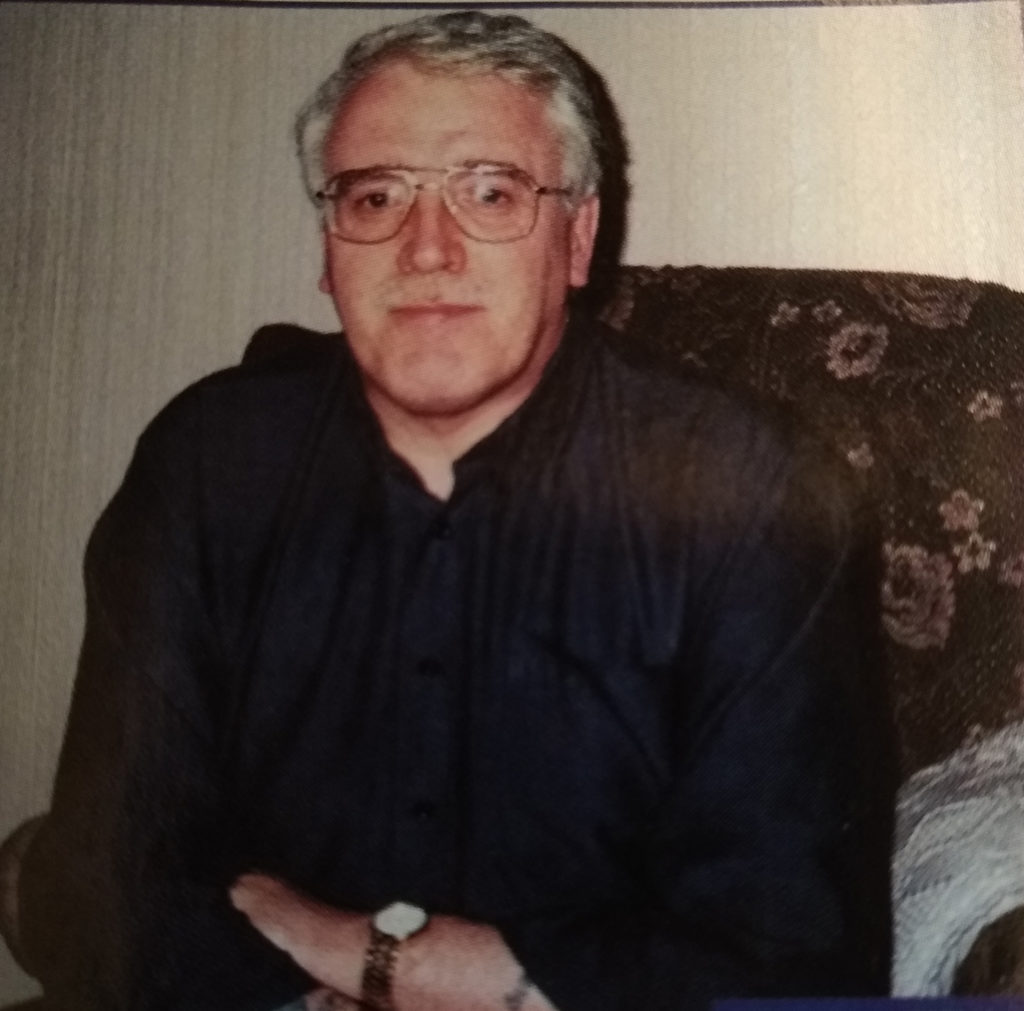
John Kelly:
“His face was waxy … I tried to rub his arms, talk to him to try to bring him round.”
Mlchael Kelly had turned 17 three weeks before Bloody Sunday. He had never been in trouble, and — unusually for a Bogside teenager — had never been interviewed by the police or army.
He was standing near a rubble barricade when he was shot dead. Three years later without accepting any liability for the killing, the British government sent Michael’s mother £250 “in a spirit of goodwill and reconcillitation.” Michael’s older brother John was also on the march that day.
We gathered in Creggan and started the march, laughing and singing. It was a cold crisp day and everyone was in good form. There was a bit of rioting going on — the usual stuff, even less. It was the norm in those days for a riot to last a full day’s business, but it only lasted fifteen to twenty minutes. It was no big deal, nothing spectacular. I decided to go and listen to the speeches.
As I was walking over I met Barney McGuigan [who was shot dead half an hour later] and a couple of other friends and stopped for a chat. After a couple of minutes I got to the courtyard area of the high flats. Someone shouted “the Brits are coming in,” so like everyone else I ran.
There were hundreds in the courtyard at the time — it’s like a U-shape. I looked to the right and it was jam-packed with people all trying to get out. I ran through the left-hand gap, and then I heard the shooting. I dived for cover and lay there for a few minutes. I realized they weren’t shooting rubber bullets — it was the Real McCoy. I don’t know why but I got up and ran across the street. As I ran I heard the whiz of bullets flying overhead.
There were some houses just being built so I jumped in behind some rabble. I saw one of my brothers-in-law there. Then there was a lull in the shooting so we stepped out and boom-boom, two bullets bounced in front of us. We jumped back in again. Then there was a complete lull so we went back across the street to the Abbey Park area. There was a crowd standing in a circle around Gerry McKinney. They thought he had taken a heart attack and were trying to resuscitate him — they couldn’t see he was shot.
Then I heard someone call me — it was one of my brothers-in-law. He and a few others were carrying my brother Michael. He had been at the back of a crowd of 30 or 40 people at the barricade and the Paras fired into the crowd and shot him.
I ran over and helped carry him to the ambulance. I think he was dead at that time. His face was waxy…I tried to rub his arms, talk to him to try to bring him round.
Gerry McKinney and Joe Mahon [who had also been shot] were put in the ambulance too. I went in the ambulance to the hospital. The doctor checked Michael and said, “I’m sorry, he’s dead.” I said to him “Are you sure? Check him again.” He did, but said again, “Sorry, he’s dead.”
My mother had followed Michael that day to keep an eye on him because it was his first time on a march. She was in a flat on Kells Walk and called to him when the Paras moved in but he didn’t hear her. The Para who fired into the crowd killing Michael was directly below the window of the flat that she was in.
My mother kept Michael’s clothes from that day all these years — socks, underpants, vest, coat, trousers, even the Baby-Gro that someone wrapped around him to stem the blood. She kept them so they’d be buried along with her when she goes. Thank God she did — now they’re evidence.
Joe Friel:
“The lead soldier opened fire from the hip, literally spraying the crowd. One had his gun in the air, and another was lifting his gun to shoot.”
John Friel lived on the eigth floor of the Rossville Flats and came down to hear the speeches at Free Derry Corner. He was 20 years old.
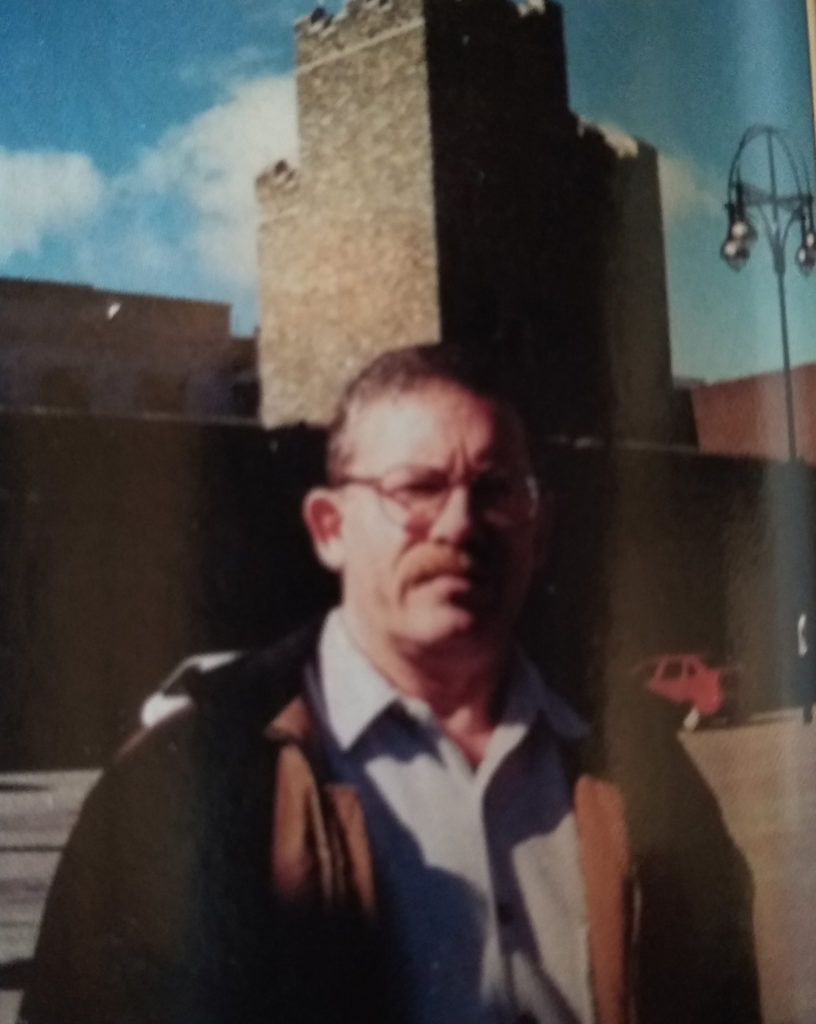
As I was heading out of the flats there was pandemonium, chaos — people running, shouting, you could hear shooting. I ran back towards the flats. I tripped and stooped to get my breath. The shooting was getting more intense.
I tried to get into the Rossville Flats but there were dozens of people packed in and I couldn’t get through so I decided to run into Glenfada Park.
You could hear single shots, then a few shots, then a whole spiel of shots. I started to run and a young fella, Gregory Wielde, shouted a warning and as I tamed round I saw three soldiers coming at me. The lead soldier opened fire from the hip, literally spraying the crowd. One had his gun in the air, and another was lifting his gun to shoot. After that I heard three or four bangs and then I felt just a tap, just a warm sensation and a gush of blood coming out my mouth.
I was hit in the chest. If I hadn’t turned I’d have been shot in the back.
Some fellas came and took me into a house and I was on the floor and these women appeared and started saying the rosary over me and I thought “Oh no.”
Then three fellas came in a car to take me to hospital but we only got as far as Barrack Street. The soldiers stopped us and later a solidier said I made a verbal admission to him that I’d had a gun. The only word to describe that is crap. If I was a self-confessed gunman forensics should have been done, I should have been arrested. I was never even questioned about the alleged admission.
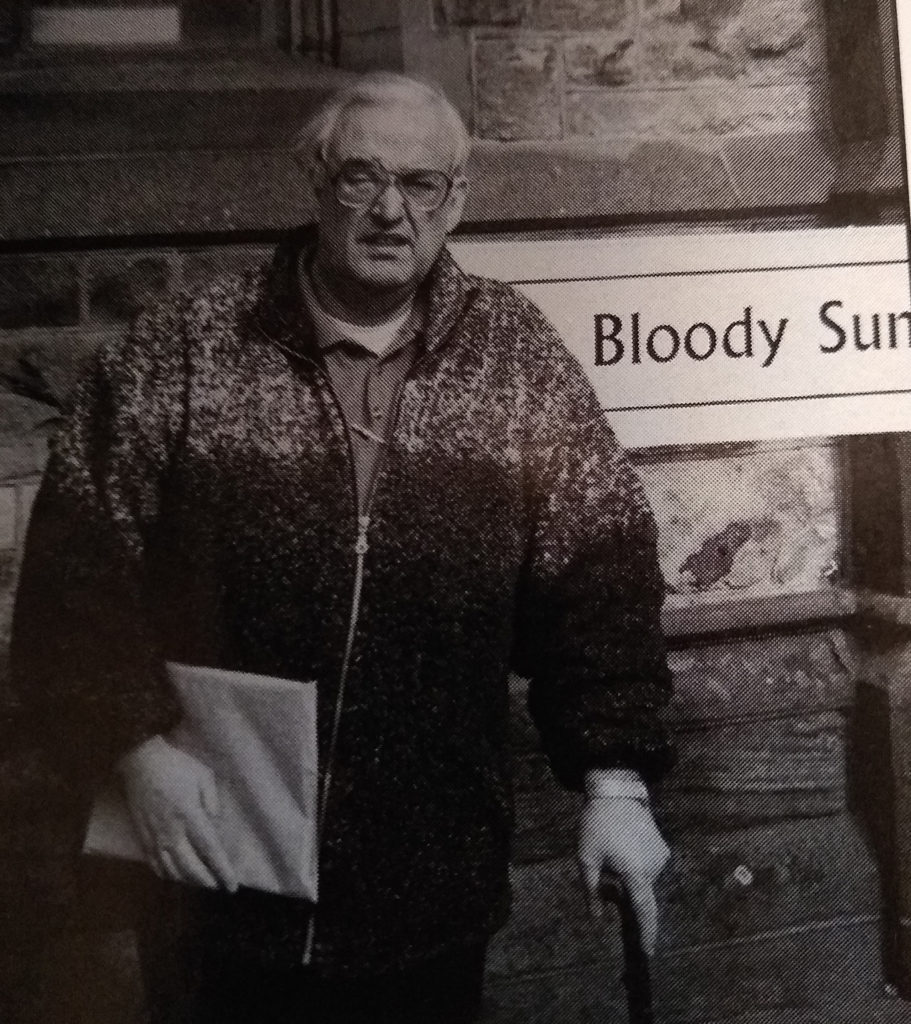
Mickey Bradley:
“I started screaming at them, ‘You bastards, you bastards’“
Mickey Bradley was 22 years old at the time of Bloody Sunday and his wife was pregnant with their first baby. He was a regular at civil rights marches.
I had no sense that this march was going to be anything different. I was near the front, about fifteen rows behind the lorry. We came down as far as the bottom of William Street, to what the Army called Barricade 14. The soldiers were saying you can’t get through. Before you knew it a riot broke out — I saw stones and some placards being thrown at the soldiers. It was your typical Deny riot.
The first thing I saw was a water cannon but it didn’t deter us altogether because people were saying “A drop of water won’t do you any harm.” We weren’t aware that two people had already been shot.
When the [Paratrooper] charge came I ran. People were shouting, “Quick, the Army’s coming in, the Army’s coming in.” I ran to the Rossville Flats, and I stopped there for a few minutes and got down on my hunkers. You could hear the shooting but I thought it was rubber bullets. A lady came past and said, “You’d better get up and get out of here because they’re shooting live ammunition. There’s a young man lying dead out here in the car park.” I couldn’t believe it.
I got up and went back to the car park — there was a crowd of about ten standing around Jackie Duddy’s body. Jackie’s older brother Billy was my best mate. When I saw it was young Jackie I was so angry and as I looked across the forecourt I could see the soldiers. I started screaming at them, “You bastards, you bastards.”
I faced them, there was nothing in my hands; no guns, no nail bombs, I just shouted and roared. Next thing I was hit — shot. It didn’t feel like a bullet, more like a punch in the right arm. Within seconds, blood came down the sleeve of my coat. All I could think was “I’m shot, I’m shot.”
I was taken into a house and laid down in the hallway — there were a lot of people around me because people were fleeing for their lives into the house.
I lay there for what seemed like ages. I worried that I was going to die and never see my child. I could feel my flesh burning. I’d been shot in the right arm, the left arm and in the chest. The priest and the first aid man lifted up my jumper and I saw the young first aid man shake his head slowly to the priest and I thought “What does he see that I can’t see?” and they quickly pulled the jumper down.
When the ambulance arrived the bullets were still flying and the priest, Fr. Tom O’Gara, went out with a white handkerchief shouting “Hold your fire, hold your fire.” The bodies of two men were with me in the ambulance.
I was in hospital until April. The left arm was a clean break — the bullet went right through it. I can no longer use my right hand — I can write my name but that’s about it. I was a painter and decorator by trade. Then the bullets in my chest — another inch and I was in the morgue.
What angers me is that the headlines are always “Bloody Sunday — Fourteen People Dead.” They forget about the people who were left injured. There could have been 27 people dead that day.
Mickey McKinney:
“I remember an army helicopter flying low above the crowd and a soldier hanging out the door giving the V-sign.“
Mickey McKinney had been on several civil rights marches before Bloody Sunday. In January 1972 he was 20 years old and going steady with his girlfiend (later wife) Goretti. He was one of ten children. His brother Willie, the oldest, was killed.
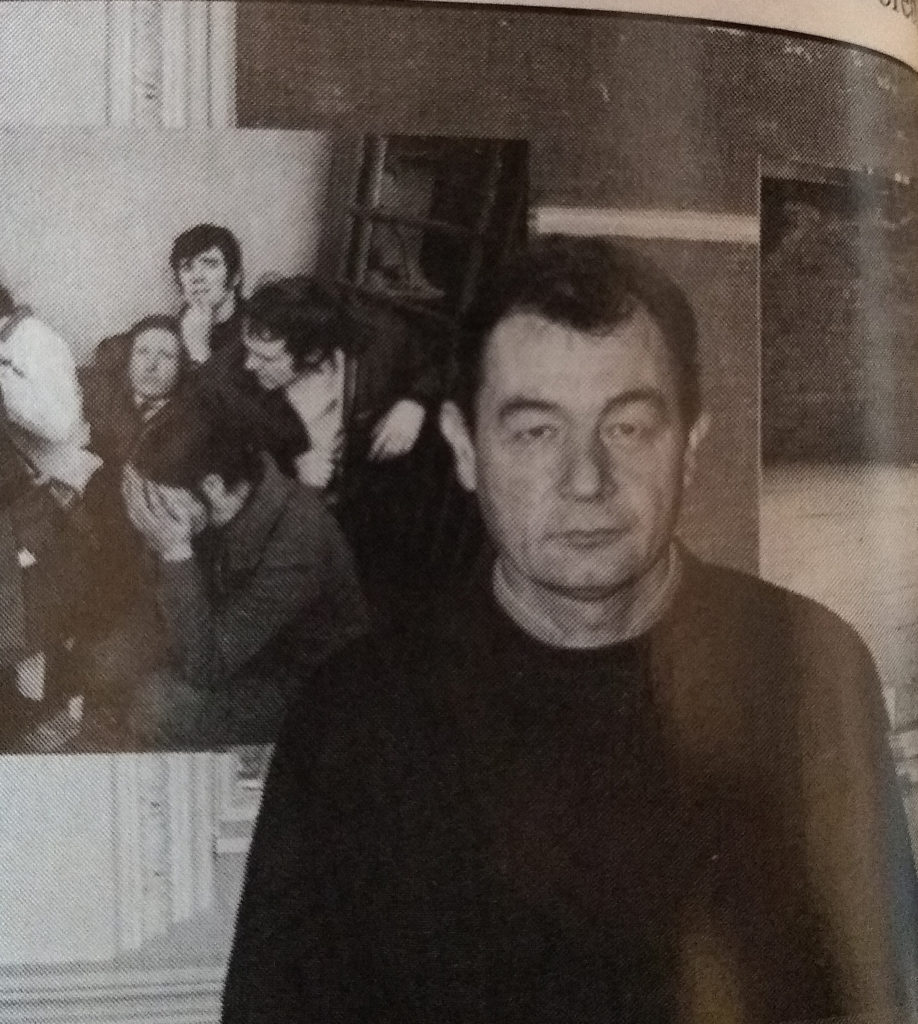
I remember Willie going out about an hour or so before we had our dinner [mid-day] and him coming back and talking about the Army presence around the town, saying that it wasn’t normal.
Willie’s favorite music was country and western. He put on a Johnny Cash LP that dinnertime. I remember one of the songs was “Sunday Morning Coming Down.” Even yet when I hear that song it takes me back. After dinner we all got ready and went to the march. Willie went with a neighbor.
I met some friends and we started off behind the lorry [truck]. I remember standing half on, half off the footpath
to stretch up and see what was going on at the barricade. There was someone with a loudhailer saying, “Will everyone make their way to the rally at Free Derry comer.” I also remember an Army helicopter flying low above the crowd and a soldier hanging out the door giving a V-sign.
I made my way down towards Free Derry corner. I moved down Rossville Street and I noticed Goretti with one of her friends. We stood talking for a few minutes, and Goretti said we should make our way to my aunt’s house because the Army was firing gas. We were walking there, just taking our time when I looked behind me and saw the Army coming in — two vehicles abreast.
All hell broke loose just as we got to my aunt’s. The house filled within seconds — the door was left open. The street was filled with hundred and hundreds of people running and screaming. I remember someone coming in and saying, “There’s five or six dead at the barricade.” This was all within a period of minutes.
My brother George came in and said, “I’m just after talking to Willie,” so I thought Willie’s all right. After things calmed down Goretti and me made our way to Creggan to her mother’s and went on to Mass. Fr. Rooney was going on about how terrible it had been, with people killed.
On leaving the chapel I said to Goretti I should go home and let my mother and father know that I’m okay. The house was full of people. My mother was sitting crying in a chair and my father came to me and said, “Willie’s dead.” He was 26.
We found out that Willie and a number of others made a dash across the south end of Glenfada Park and while they were doing that the Paras entered the north end and they came in spraying. There were nine shot in Glenfada Park. ♦
Editor’s Note
The 2010 Saville inquiry, which took 12 years to complete, exonerated the dead and asserted that none of the victims posed a threat to soldiers when they were shot. In 2012, a new investigation into the events was launched, and in the following year, the Ministry of Defense offered the families of the victims £50,000 each. Not one of the families has accepted the money. To date, the only British soldier charged with murder in the “Bloody Sunday” killings will not face trial, the North’s Public Prosecution Service (PPS) announced on July 2, 2021. The families continue to fight for justice.
This article was originally published in the June / July 2000 issue of Irish America.
♦

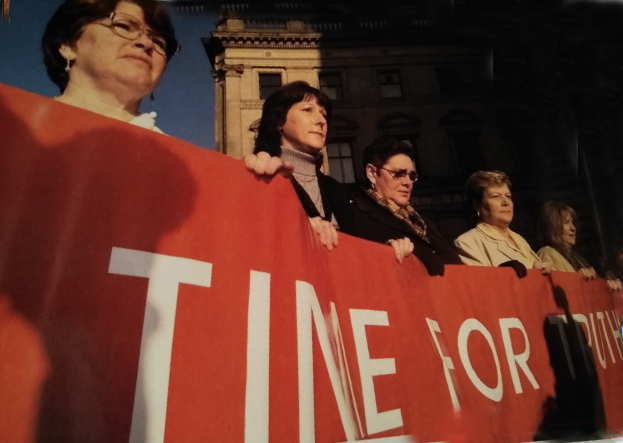
Leave a Reply